by Winding Pathways | May 3, 2018 | Birds, Mammals, Nature
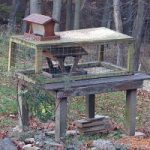
Keeping Squirrels at bay
Bruce Frana, a Winding Pathways visitor, saw one of our blogs on our “squirrel proof” feeder and how we discourage squirrels from gobbling up sunflower seeds we put out for birds. He crafted a similar but much more attractive version that’s in his yard. Our contraption is a box framed with 2X2 lumber with sides of 2” x 2” wire mesh. A piece of plywood forms the roof, and we attached it to a wooden table with a pair of hinges. The hinges let us lift the cage to sprinkle sunflower seeds inside.
It works. Sort of. Cardinals, chickadees, and nuthatches easily pass through the wire mesh to feed. Some squirrels and wild turkeys, which we like but get frustrated when they gobble up all the seed, can’t get through the mesh. Our fox squirrels are too chunky to squeeze through, but smaller gray squirrels manage to get in and gobble seeds. We could keep the grays out if we could find 1 ¾ x 1 ¾ mesh wire on the market. As far as we know it doesn’t exist, but if it did it would let birds in but exclude even the skinniest gray squirrel.
Bruce reports that his fox squirrels can’t enter either but the grays do. Here is a photo of his squirrel foiling feeder:
Do It Yourself “Squirrel Proof” Feeder!
Here is what he shared: “I have had a platform feeder for several years but, like your blog mentioned, turkeys, and even some clever squirrels, were able to get on top of it. I built (a feeder) based on the plan/picture you shared on your blog. I adapted the plan to the platform feeder I had and made some of my own modifications.
“As you can see from the pictures, I attached the structure onto the original platform by using hinges, just as your plan had done. I also put a pitched roof and handle to be able to easily lift the one end to place seed on the platform. The entire system is attached to a 2″ PVC pipe that slides over a steel post. I have had one ingenious small grey squirrel figure out how to get into the feeder and solved that problem, at least for now, by making the wire openings a bit smaller on two sides.” It works…sort of!”
Readers can go online and find “Do It Yourself” (DYI) “squirrel proof” feeder instructions. Good luck and let us know how it goes! Thanks, Bruce Frana.
-
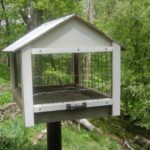
-
Adaptation to feeder
-
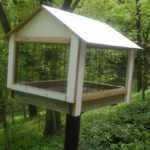
-
Back View of feeder
by Winding Pathways | Jan 25, 2018 | Mammals, Trees/Shrubs
Winter is the best time to spot dens and nests. Usually, we think of bird nests, and we see abandoned ones topped with mounds of snow along roadsides and in shrubs. When we look up, we also spot large clusters of leaves and sticks – squirrel nests.
Squirrels make two types of nests: dens and dreys. Dens are cavities in trees and dreys are the large balls of leaves and sticks that squirrels fashion. From the ground, these dreys look small, but they are really good sized.
Dens
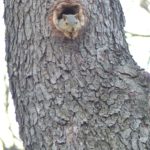
Taking in the view from the safety of a tree den.
When squirrel families mature in late summer, the young venture forth to find new lodgings. If the population of squirrels is low and the availability of hollows in trees is high, then squirrels take the dens. These are hollow spaces inside the trunk that squirrels line with leaves and bits of fur and bark. Squirrels do not create these hollows but use them. Wood rot and woodpeckers create the spaces and squirrels make the most of them. Dens offer great protection from the elements and predators and they are warmer. So, squirrels conserve their energy when they must “hole up” during winter storms. When the worst of the harsh weather passes, squirrels begin to stir, digging for nuts and raiding bird feeders.
Dreys
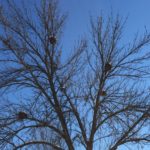
Squirrel Condominium
Squirrels make their dreys near sturdy forks in branches or close to the tree trunk. They will be high up for protection from predators. Usually, a tree might support one or two squirrel nests, but occasionally, we see half a dozen scattered throughout a wide-branching deciduous tree. Squirrel condominiums. These might be secondary homes or extensions of families. Secondary homes tend to be more loosely constructed and are scattered near the main home tree and serve as shelter in case a squirrel gets caught out in the elements or is being chased by a predator.
Each nest begins with a study base of twigs. Scientists have discovered that sometimes squirrels weave grapevines into the structure along with leaves, bark, moss, and twigs for added support. After all, the nest sways in the branches and get buffeted by winds, rain, and snow, so it needs to be strong. Inside, the nest is dry and warm.
When you are driving or walking look up and spot the nests of one of our most industrious small mammals. Squirrels mate in January and soon the young will be born – in the bleak mid-winter maybe in a squirrel condominium near you!
by Winding Pathways | Nov 10, 2016 | Birds, Nature
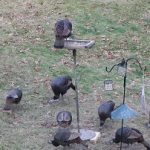
Turkeys and squirrels would make short work of seed, leaving none for the small birds.
Nearly everyone who feeds wild birds sees squirrels gobbling up expensive seed. Elaborate and expensive feeders help birds eat while excluding squirrels. We use a different method.
Plenty of squirrels make Winding Pathways home. So do wild turkeys. We enjoy watching them and don’t mind giving them some seed. Unfortunately, they come in droves and wolf down all the seeds. Each morning we sprinkle some seeds on the lawn for both turkeys and squirrels but we needed to keep them away from a feeder favored by cardinals, chickadees titmice, and other birds.
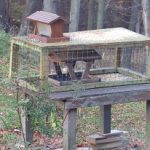
This homemade excluder seems to stop squirrels and turkeys while allowing in songbirds.
We built a simple but effective squirrel and turkey excluder out of scrap lumber. It’s merely a rectangular box two feet wide and four feet long. The frame is made of 2×2 lumber, the top is of treated ½ inch plywood, and the sides are of 2×2 inch mesh heavy wire. There is no bottom.
We placed a feeder on a homemade picnic table and put the turkey and squirrel excluder over it. One end of the excluder is hinged to the table, making it easy to lift the other side to fill the feeder.
So far squirrels and turkeys have not been able to infiltrate the excluder and stay outside enjoying the cracked corn we’ve spread specially for them.
by Winding Pathways | Nov 30, 2015 | Mammals, Nature, Pests
We love watching frolicking squirrels in our yard and every year we buy bags of corn for them to snack on. We draw the line when they climb up to feeders and gobble expensive seeds meant for chickadees, nuthatches, and woodpeckers.
Bird feeder companies all tout their “squirrel proof” feeders and a homeowner can spend a bundle on different feeders just to slow the flow of seed from feeder to squirrels’ mouths. Some preventions work better than others but a reliable company is Droll Yankee.
But, being partly of Yankee stock, we took the economical route. To thwart the hungry mammals we mounted our feeders on steel pipes and even ringed some with metal stove pipe. Somehow they managed to dig claws into the metal, climb and feast on expensive seed.
Then we discovered spray grease. It’s sold in hardware stores and is meant to spray on drawer slides, hinges, and other balky metal parts. We sprayed it on the metal pipes holding up the feeders. Squirrels gingerly put their feet on the pipe and backed off as soon as they felt the grease. It works.
Spray grease only lasts a few weeks and needs to be reapplied, but it is a simple way to discourage squirrels from climbing to feeders.
-
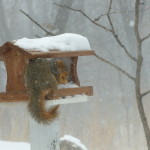
-
Even in the teeth of a storm, squirrels feast to tide them over.
-
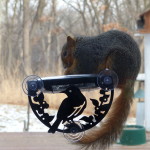
-
Boldly the fox squirrel hunkered down at the window feeder.
-
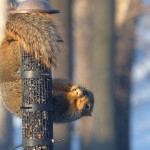
-
Quite the acrobat, this squirrel hung for more than 30 minutes eating seed.
-
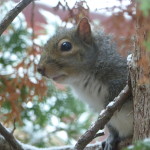
-
A cautious squirrel scoping out the action.
-
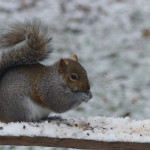
-
A hungry squirrel
-
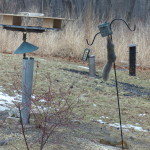
-
Squirrels have an amazing ability to climb just about any vertical pole.
-
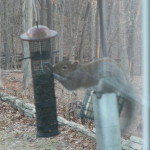
-
This squirrel learned to climb the metal deflector pole and reached into the hanging feeder.
-
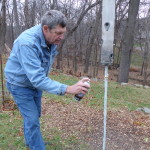
-
This grease works for a while. Remember to re-apply.
by Winding Pathways | May 1, 2015 | Mammals, Nature
Squirrels are probably North America’s most acrobatic animals. They’re able to do seemingly impossible physical maneuvers.
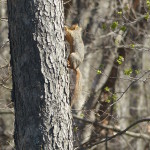
Squirrels “wrists” articulate so they can climb agiley up and down.
One is hanging by their rear toes to snatch seeds from a hanging feeder. How do they do it?
Raccoons and house cats can climb up trees fairly rapidly but descending back to earth is a problem. Both must creep down tail first. It’s awkward and slow.
Squirrels, in contrast, can go up and down head first quickly and gracefully thanks to a special adaptation. Their ankles, or wrists, articulate. The squirrel may be heading down the trunk but its feet and claws point upward, enabling a good grip on the bark and a speedy dexterous descent.
Squirrels are outstanding tree climbers but once in a while they slip and fall. Twice at Winding Pathways we’ve seen squirrels fall from the top of big oaks. As they fall the hapless animals flattened themselves out and hit the ground like a swimmers belly flop. In both cases the animals shook themselves, looked around and scampered off unhurt. Imagine what would happen to a human falling 50 feet!
Next time you spot a squirrel hanging from a feeder or scampering down a tree examine its feet through binoculars. You may see upward facing feed on a downward facing animal. You Tube has some great close ups of squirrels paws and wrists. Enjoy the show!
















